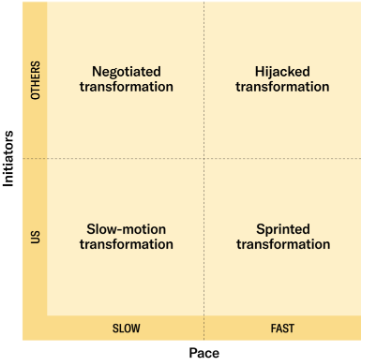Author: Alexandre Palma
Nowadays, due not only to the constant technological advances but also to all the uncontrollable factors that we are obliged to deal with (covid-19 and the current war in Ukraine example), a door opens to the constant need for transformation of businesses and companies.
This transformation is a process seen as something recurrent in the business environment, any company that wants to be at the forefront of its sector must reinvent itself and transform not only in digital terms but also in strategic and environmental terms.
The success of a business or a company depends largely on the ability to adapt and reinvention in this business context that is increasingly aggressive and brutal not only given the “normal” competition between companies but also due to the various factors mentioned earlier.
Thus, according to the authors Carsten Lund Pedersen and Thomas Ritter, it is possible to develop four types of business transformation based on two points: 1) “Is transformation driven by internal organizational needs (internal agents) or forces outside the organization?” and 2) “What is the pace of transformation?”
Following these 2 points, we can then identify four different types of transformation, Negotiated transformation; Hijacked transformation; Slow motion transformation; Sprinted transformation.

Slow-motion Transformation
As the name implies, this is a type of slow transformation given the time interval in which it is performed. This transformation occurs over a long period, with managerial and cultural changes happening over several years or a decade.
This transformation is developed by companies that spend more time supervising the various changes in operations, which should, in theory, allow for more cunning and conscious decision-making on the way forward.
An example of this change occurred at Microsoft in 2014, when Satya Nadella, the CEO, decided to change significantly, shifting away from the hardball agreement, and rejecting open-source technologies.
Sprinted transformation
Unlike the slow-motion change, we have sprinted transformation. This type of transformation happens for several reasons, but often this transformation is justified by the need for a company to stand out before its competitors, bringing a disruptive technology or a new product, in the background the company hastens its transformation process to be the pioneer
This type of transformation happens mainly in companies that supply some service or technological product, because technology is a sector in constant evolution and in which changes occur at a breakneck pace.
That was the case, for example, with Meta Platforms’ transformation in 2021, previously known as Facebook. CEO Mark Zuckerberg announced the name change in October 2021, and quickly got the memo out that virtual and augmented reality were the key areas for the next few years.
Negotiated transformation
A negotiated transformation is a long-term response to external demands, typically changes in national or international laws that require internal adjustments to an organization or its content. These take place over several years and businesses of influence can negotiate the new regulations, and work with those crafting the rules to ensure as minimal disruption as possible.
Hijacked transformation
Sometimes, when dealing with a national or international legislative body, there is no recourse from the decisions made by the legislature. This is considered a hijacked transformation, where an organization must quickly deal with external issues and align the business with new realities.
As we know, with the US-China trade war, organizations were given a short amount of time to remove all Huawei products from their infrastructure or face heavy fines for breaking trading laws. Almost all businesses that operate in the US and Europe quickly removed Huawei’s infrastructure.